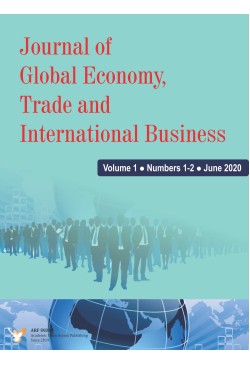
Journal of Global Economy, Trade and International Business
Frequency :Bi-Annual
ISSN :2583-0112
Peer Reviewed Journal
In this paper, we investigate the impact of trade and financial integration on economic growth and income inequality in 35 OECD countries over the period 1995-2016. Ourcontribution to the empirical literature is threefold: i) we disentangle the impact of economic integration in short and long run using an error correction model applied to panel data; ii) we differentiate estimates for low, middle and high income groups of countries and iii) we evaluate the impact on growth and inequality of global financial crisis, institutional quality and trade agreements. Our results show that trade integration was positively associated with Gdp growth per capita and negatively with inequality. The impact of financial integration was mixed. We find a positive relationship between financial integration and growth in the short run for middle income countries and a negative linkage with income inequality in the long run in low income countries.
Keywords: Trade integration, Income inequality, Panel data analysis
JEL Classification: D63, D31, 015, H23
While Thailand seeks to further open its economy through more open trade and investment, the new development context, dominated by such major drivers as climate change and disaster risks, and induced policy changes, set to become new factors shaping both its agricultural production, and trade policies. Acknowledging the importance of maintaining the balance between domestic food security and serving the world hunger, Thai governments have had great influence over the recent years on production and trade of agricultural products. Thailand’s engagement in bilateral and multilateral free trade agreements testifies to this claim. Using desk-top research and secondary data, this paper argues that such external factors as climate change will pose new risks to shaping future trade. It then investigates the compatibility of a common trade rule under FTA, which enables Thailand and South Korea to increase their trade tie, and to possibly deepen other forms of technical cooperation that would be win-win, especially with the fast changing development context aforementioned. Specifically, it found that technical barriers remain intact, despite the fact that mutual benefits could be reaped from more open trade regimes. Technical cooperation is therefore of mutual interest, using an example from the case of mangosteen export from Thailand to South Korea.
Key words: tropical fruit; climate change; FTA; technical cooperation; agricultural policy
JEL: F130; F140; F190
There four Latin America countries in the Pacific Alliance formed with the Declaration of Lima agreement in 2011, in recent years after the global financial crisis. The impetus was to establish and area for mutually supportive trade and investment. Beyond the emphasis on trade in goods and services, the Pacific Alliance supports the mobility of people and higher education exchanges. This regional trade agreement is compared to the European Union, which has even deeper integration through an established common market advance to trade, the Single Market, since 1992. Through the Bologna Process, launched in 199, the EU and neighboring countries established the institution of the European Higher Education Area (EHEA), in 2010.
Both trade and higher education have continued to expand in the region in recent years. The pandemic of early 2020 has brought a pause to the expansion of education exchanges. Globalization has results in policies of internationalization, and multilateral institutions have provided the framework for cooperation.
Keywords: European Union, higher education, Pacific Alliance, regional integration, trade
The establishment and rise of Low Cost Carrier (LCC) is a strategy of reducing costs. In this work, we have used the Grey prediction connotation model to establish a reasonable price measurement model and select the LCC routes in Taiwan for an empirical study. Firstly, it has been found that the LCC reasonable price measurement model constructed using the Grey prediction connotation model achieves accuracies above the qualified level, which verifies that the Grey prediction connotation model is able to provide a decision-making method for LCC managers to evaluate the reasonable prices. Secondly, the comparison between the reasonable fare price level of the LCC routes and the average price level allows the managers to determine whether the pricing strategy belongs to the high price or low price strategy. Finally, the LCC reasonable price measurement model can be used to know determine the proportion of the LCC routes that adopt the low price or high price strategy in the budget aviation market composed of LCCs, so that the managers will able to make follow-up decisions and rank the generated pricing. The research results from this study may provide a reference for airline managers in decisionmaking with respect to the price competitions.
Keywords: Low Cost Carriers (LCC), GM (1, 1) model, Grey prediction connotation model, reasonable prices.
JEL: C60, M21, P22
The first three industrial revolutions were all about the mechanization of production using water and steam power; electric power; electronics and information technology respectively. The Fourth Industrial Revolution (FIR) is the off-shoot of the digital revolution [the third revolution]. Exponential expansion through merging technology is what leads to the revolution at the fourth level. The effects of such revolution can be seen at all levels of production, governance and management systems. The work environment around the world is rapidly changing because of technological breakthroughs achieved in terms of the industrial revolutions. Therefore, the present study is trying to find out the role of the fourth industrial revolution towards employment generation and skill development across the world economies. Further, it evaluates the significance of the fourth industrial revolution in the present situation of the COVID-19 pandemic.
Key Words: Fourth Industrial Revolution, Employment, Skills, Sustainability, COVID-19.
JEL Classification Code: J21; J 24; O39